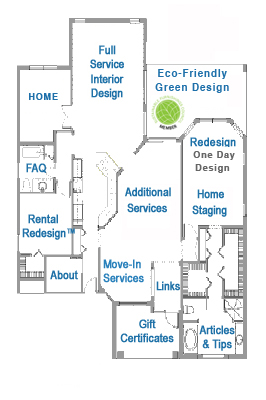
Serving:
New
York Greater Metropolitan Tri-State Area (NY,
NJ, CT)
Peggy Berk IDS - Associate Certified Interior Redesigner Telephone: 917.754.6535 pberk@areaaesthetics.com

|
||||||||||||||
Creating
Flow with Design and Color

By
Peggy Berk, Area
Aesthetics
Flow is an important concept in interior decorating. Traffic flow is a major consideration in furniture arrangement. The way we flow patterns and colors around a room is a key element in setting a room's tempo. And, when adjoining rooms don't flow harmoniously into each other, spaces feel fragmented, smaller and uninviting.
There are no hard and fast rules about flow when it comes to adjoining rooms, but there is an overriding objective - to create a sense of continuity that can bring disparate design elements into a harmonious whole.
The easiest way to achieve good flow in you home is to select a design element and repeat or restate it in each room in a manner appropriate for the room. A consistent color palette is one option. Simply vary which of the colors is used as the primary and which as the accents as you move from room to room. Other ways to achieve flow are with the use of a particular motif or decorative material. Trim molding, painted a consistent color throughout, is another frequently seen means of creating continuity.
If you're a bit adventurous in your decor, you might try thinking out of the box when it comes to flow. I've seen identically matted and framed black and white photographs snaked gallery style throughout an open plan loft used to great effect. One of my favorite homes has walnut stained dentil molding used not only on the interior walls, but also as trim on all the cabinetry and door frames, as well. Because of its small scale, it provides a great sense of flow without ever becoming overpowering or boring.
One of our readers asks:
Q. What color ceramic tile I should put in my foyer. To the right is my living room with pecan stained wood floors. At the end is the entrance to my kitchen with black & white ceramic which can be seen from both the foyer and living room. We do not love the the kitchen floor and will probably change it to wood floors in several years. I would like it to flow from one room to the next.
A. Because you are in transition and floors can be an expensive element in any room, rather than look to your floors to integrate the rooms, I would suggest that you use color to provide continuity in the three areas. Pick a dominant color from either the living room or kitchen and work it into the other areas as an accent. For the floor in the foyer, you can then choose a tile which will carry you through the transition and beyond.
I suggest that you use a low-contrast grey marble tile. The background should be a soft grayish white with veins ranging from light to medium grey. Because foyers can be wet areas in inclement weather, stay away from high polish finishes that can get slippery. Marble is beautiful, elegant, extremely durable and timeless. It is a classic look that can work with any style decor and will set off your pecan floors beautifully without competing for attention with the high contrast black and white floor in your kitchen.
If you're not ready to splurge on real marble, there are also very good looking artificial marble tiles on the market which can be used just as effectively.
Q. My home has an open plan with the kitchen, dining area and living room all visible at the same time. I don't want to use the same paint color in all areas, but I don't know how to get a good flow without doing that. Can you suggest an alternative?
A. There are a number of alternative ways to get good flow throughout your open plan without resorting to the use of a single paint color. One of the most effective techniques - which will help to define the various areas - is to use a monochromatic scheme. Use the lightest tone of your color in the largest areas and what you visualize as your connecting spaces. Then frame each functional area by painting at least one wall that is visible from the larger space in a deeper, more intense version of the color. If you want a more dramatic effect, use a high level of contrast in your tones to define the areas.
Another very colorful alternative is to start with a neutral on the largest and connecting areas, and then select a triadic scheme (three colors equidistant on the color wheel). Use each of these triadic colors to frame one of the areas.
As with any color scheme, make sure to pull your colors off the walls and into your room, integrating your colors throughout your space in your furnishings and accessories.
About the Author: Peggy Berk is an award-winning interior designer and certified interior refiner serving both residential and commercial clients. Her company, Area Aesthetics, provides full service interior design and decorating for complete interiors, one day interior redesign, home staging services, art and accessory styling services, color consultations and shopping services.
`
COMING
SOON
Rental Redesign™
www.rentalredesign.com
a new publication based on
Peggy's popular
"Rental Redesign" column!
Bringing you original articles
every month
by some of today's
top interior redecorators.
Resale Redesign Home Staging Rental Redesign FAQ
Decorator Consulting & Shopping Services
Full Service Interior Design Decorating Gift Certificates
About Peggy Berk and Area Aesthetics Contact
Move-in Services Decorating & Interior Redesign Links
Interior Redesign Articles, Tips & Decorating Ideas


